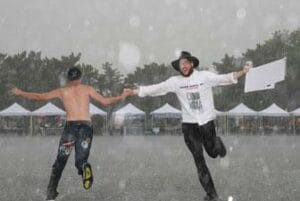Click here to view a PDF of the calendar
A Russian-English language Jewish calendar depicting the grandiosity of Jewish life through symbolic art was distributed this week by FREE, Friends of Refugees of Eastern Europe to some 170,000 Russian-Americans. The release took place a few weeks before Rosh Hashana, the Jewish New Year of 5766, as FREE winds down its year-long celebration of its 36th year of operation.
The calendar features the awesome post-realistic paintings of Yossi Rosenstein of Bnei Brak, Israel, whose acclaimed works focus on Biblical themes based on events such as The Exodus or the Holiday Ascent to Jerusalem as well as the theme of “People of the Book.”
Called the Filimonov Jewish Russian Calendar, the 32-page-document was underwritten by Mikhail Filimonov and Vadim Iosilevich, among the first Jewish émigrés to arrive here from The Soviet Union when it was still near impossible to get out of that country. Mikhail and his brother Gennady were two of the FREE’s first bris (circumcision) cases way back in 1970, shortly after FREE was established at the directive of the Lubavitcher Rebbe, Rabbi Menachem M. Schneersohn.
Among the Rosenstein paintings in the calendar are powerful depictions of the Bnei Yisrael, The Children of Israel, in what appears to be the Sinai or Judean mountains and deserts. We see them worshipping as a people although their faces and bodies are not shown. In another painting, torrents of water gush out of an enormous rock, at least 10 stories high, presumably to quench the thirst of more than three million Hebrews who left Egypt while a Moses-like figure stands near the rock with staff and arms outstretched.
In a third painting, we see a black-hatted figure like a Lubavitcher chassid playing a concert grand piano on the shores of a river although we don’t see his face. Rising to the heavens from the piano is the curled-up piano keyboard. The caption reads, “Great is the power of a melody for it reaches into the higher spiritual realms.” In a fourth, we see over a thousand sifrei Torah, Torah scrolls, perched like people on the desert-floor landings. On the side is a gigantic mountain Torah scroll wrapped in a mountain-sized talit (prayer shawl).
Mr. Rosenstein, reached on his mobile phone in B’nei Brak, described his paintings as “symbolic art.” He believes he is the first Jew to engage in the genre of symbolic art on Torah themes. “There were no Jews doing this kind of art,” he said. In the late 70’s, he recalled, the Lubavitcher Rebbe examined a catalogue with his paintings and approvingly remarked in Hebrew, “It is high time that the visual arts were redeemed.”
Mr. Rosenstein says his symbolisms complement the Torah, which are both unspecific. The Torah, he explained, does not describe people’s features or their clothes, except for the high priest, the look of their homes or the surrounding terrain. Apparently, he theorizes, Hashem wanted to keep these images mysterious so that each child or Torah student would envisage for himself the appearance of Moshe Rabbeinu, say, or what the scene of Abraham ushering in the three angels looked like. Rosenstein said he has worked to maintain that quality of mystery in depicting scenes related to the holy Torah.
The artist said his family lived in Israel for nine generations. Born in Jerusalem, he attended a number of prominent yeshivot and received his semicha (ordination) as rabbi. He said his greatest joy was to open a new avenue for ba’alei teshuva (returnees to the faith). “I want to help bring back our people through the language of art,” he said. “My art is an instrument of bringing back those who got lost.”
The front cover shows a figure blowing a shofar (ram’s horn) surrounded by mountains, ravines, the Kotel, smoke rising to the clouds, men wrapped in talletim and people in awe and prayer. It is a fascinating mélange of derivative Exodus scenes. Yet notwithstanding Rosenstein’s works, the calendar is still dominated by the Lubavitcher Rebbe, who founded FREE in 1969 at a time when the exodus from Russia was but a trickle.
The colorful calendar notes all the Jewish holidays and fast days—major, minor and Chassidic—as well as major American holidays. It is written mostly in Russian but is accompanied by enough English to make it useful to both communities, especially to American Russian families were you typically find their children reading English and the parents reading Russian.
The calendar is prized by the Russian-American community and is kept in people’s homes for instant reference and enjoyment. It provides candle-lighting time for 27 cities around the world, lists the 12 FREE centers and the 17 FREE divisions and programs. Its has been designed expectantly by Rabbi Ephraim Stock and published by the FREE Publishing House under the guidance of its director, Rabbi Yosef Y. Okunov.
“The 5766 Filimonov Calendar sums up in text and graphics much about our faith, our history and the basic day to day practice of the Jewish law” said Rabbi Mayer Okunov, Chairman of FREE.
Thirty-six years later and after 13,000 FREE-sponsored circumcisions of Russian-Jewish immigrants, Mikhail and his family are thankful for the opportunity to underwrite the creation and distribution of the Filimonov calendars that is informing Jewish Russians in cities around the world about their religion.
We have come a full circle wherein FREE’s alumni’s are continuing to provide material and religious assistance to Russian immigrants here and those still arriving, reflects Rabbi Okunov.
Contact FREE Publishing House to receive a complementary copy of the calendar.




